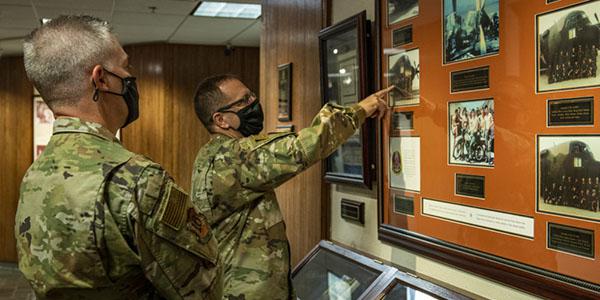Taking an Accelerated Information Warfare Approach
The U.S. Air Force’s Air Combat Command and the 16th Air Force are taking further steps to advance the service’s information warfare operations. Championed by Air Combat Command’s (ACC’s) so-called A2-6 leaders, the “accelerate information warfare” approach requires the correct data management strategy, the right teams and problem-centric operations, officers say.
Brig. Gen. Robert K. Lyman, USAF, assistant deputy chief of staff, Cyber Effects Operations, Headquarters U.S. Air Force, explained that the service has successfully integrated information warfare disciplines at the Numbered Air Force (NAF) level (in the 16th Air Force), which brought together cyber information operations; electromagnetic spectrum operations; intelligence, surveillance and reconnaissance (ISR); and weather intelligence operations. However, work still needs to be done at the headquarters level.
“At the NAF, they’ve been integrated and now at the Air Staff, we are still working to organize, train and equip and provide resource policy guidance for those sorts of functions, beyond just the typical stovepipes that they've grown up in,” Gen. Lyman stated. “One of the big things we have to focus on is to make sure that the decisions we make are threat informed. Information warfare covers that great power competition across the spectrum from competition to crisis to high-end conflict.”
At the same time, U.S. adversaries are moving quickly into artificial intelligence (AI), machine learning, information and asymmetric warfare, and of course, cyber. “And so, we are looking at what are we doing to counter those capabilities,” the general noted. “AI-enabled advances in cybersecurity and cryptography, and in the future, quantum computing, could enable adversaries to harden their systems to deny remote penetration of their networks. And obviously we want to flip that and be able to do the same to them. Once inside, foreign intelligence can exploit adversarial AI and insert poisoned or false data into training sets to degrade those algorithms that we are trying to build in case AI systems to fail.”
He stressed that it is not only important to have secured data but secured algorithms as well.
The service also is examining field-resilient, adaptable, expeditionary communications to connect to data sources. It is looking for mobile command and control and mobile expeditionary communications capabilities underpinned by cybersecurity. In addition, a combined joint all-domain command and control (C-JADC2) solution requires resilient responsive network architectures, that are federated with the Joint Force, allies and partners, would give warfighters the ability to maneuver adroitly in the electromagnetic spectrum. This kind of deployable, expeditionary network extensions would enable the Air Force’s vision of agile combat employment (ACE), Gen. Lyman stated.
The demand signals from some of the Air Force’s major commands—such as the United Air Forces in Europe and Africa, and Pacific Air Forces—to employ ACE are driving the need for deployable expeditionary network extensions. “We've got to be able to take that JADC2 network that we're creating and extend that tactical locations,” the general noted. “They want to be able to take their wings, deploy them forward and move them a lot more rapidly than we have perhaps in the past. In the past, we've moved forward and created a tactical air base and fought from there. The vision now is maybe we only fight from a location for a week or two, and then we move to a new location, so much more agile than we are today.”
On the defensive side, ACC’s endeavor to broadly put in place cyber mission defense teams (MDTs) to protect Air Force weapon systems is succeeding, confirmed ACC’s outgoing A6, Brig. Gen. Chad Raduege. The service has implemented a common weapon system and command-and-control structure for the MDT operations. On the schoolhouse side, formal training is set up at two bases, Little Rock and McGhee Tyson, supported by total force partners from the Air Force Reserve and Air National Guard.
“They're helping us train the next generation of MDTs,” the general noted. “And we have pushed past not just a common weapon system but now we're figuring out what the next steps are, and a lot of that is putting in some agile code in a cloud environment and allowing programming, coders on each particular weapons system to pull the code that they need to protect our weapon systems. And it is this collaboration, this partnership that's taking place between the cybersecurity professional, the maintainer and the operator that is going to create a very powerful group that will come together.”
Gen. Raduege suggested that the service will now have to make some important changes in deciding where the Department of the Air Force—including the Air and Space Forces—will next invest heavily in IW.
He applauded the standing up of the Cybersecurity and Defense Field Training Unit at Keesler Air Force Base, which will train airmen heading to Cyber Security and Control Systems (CSCS) operational units. The delivery of standardized initial qualification training, or IQT, to the cyber operators before they have to employ the cyber weapon system in their units—when protecting the Department of Defense Information Network, for example—will make the operators more prepared and alleviate the unit’s task of having to train them during mission operations.
“They were finding that they were trying to train and operate the weapons system at the same time, and that was just an inappropriate way of doing business,” Gen. Raduege said. “In the world that we are in, we need to keep our operators focused on running the network and protecting the network. And now we have the training professionals that are all ready to go.”
In addition, the Air Force is greatly expanding its pursuit of zero trust, he said. “I have talked more about zero trust in the last several months than probably any single subject,” Gen. Raduege noted. “And I think that's an important highlight of zero trust architecture and the strategy that we're trying to build.”
Meanwhile, Brig. Gen. Brad Pyburn, USAF, deputy commander, 16th Air Force, confirmed how the NAF is generating information warfare outcomes daily. The 16th Air Force is advancing its offensive cyber, ISR collection and analysis, cryptologic operations, electromagnetic spectrum operations, nonkinetic and kinetic targeting and target system analysis, weather intelligence, network operations defense and precision information operations, amongst other activities.
“We really see the 16th Air Force as the competition force,” he says.
The NAF has nine wings, with each having unique ISR responsibilities. The 16th Air Force serves as the service cryptologic component, the defense intelligence component, and the component NAF. It houses the Air Force information network operations commander and is responsible for presenting Air Forces to U.S. Cyber Command.
In addition, the NAF aides the Joint Interface Control Cell, or JICC, which provides key air domain awareness for joint task force operations.
All of these capabilities are necessary and must advance, the general stressed, given the threat from U.S. adversaries. The People's Republic of China has 50,000 to 100,000 hackers as part of its cyber military operations, “a significant amount of capability that weighs against what the United States has,” Gen. Pyburn stated. Russian operators are masters in cryptology, espionage, psychological operations, offensive cyber and influence operations. Their cyber diplomacy doctrine is designed to gain strategic advantage in the information environment.
It is China’s ‘whole of nation’ approach, its united academia, military, industry and space organizations toward its goal of world dominance, that gives the general pause, however.
“We’ve never faced a potential adversary such as China,” he warned.
The three leaders spoke at AFCEA Tidewater’s Integrated Cyber Symposium (TWICS) pre-event last month. The chapter is hosting another TWICS pre-event on October 21, 2021, followed by its annual in-person TWICS conference May 2-5, 2022 in Hampton, Virginia.





Comments